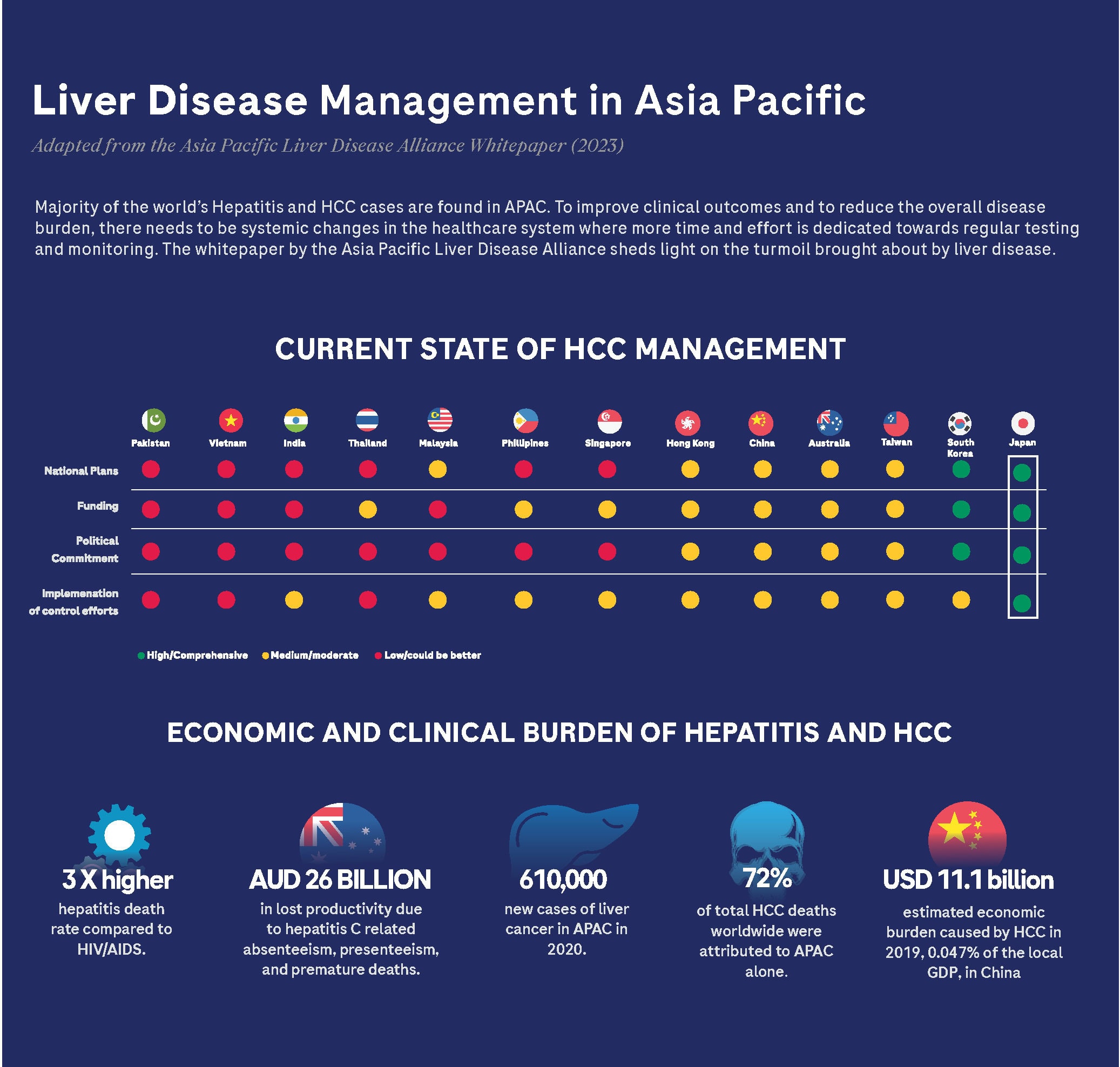
The Asia Pacific region faces various resource challenges and access barriers to healthcare. Navigating these challenges requires an innovative approach to enhance liver disease management.
Micro-elimination strategies might just be the solution to improved patient care.
The past decade has seen the World Health Organization (WHO) set forth ambitious goals for the elimination of significant adversaries to global health, specifically hepatitis and its complications, such as hepatocellular carcinoma (HCC). Viral hepatitis, particularly types B and C, represents a substantial threat to public health worldwide. Chronic infection can lead to severe liver damage, and may result in HCC, one of the most prevalent types of liver cancer. Annually, over a million around the world succumb to conditions related to acute hepatitis and chronic infection, resulting in liver cancer and cirrhosis – a death toll three times higher than HIV/AIDS and nine times higher than malaria.1
Chronic hepatitis B and C infections are the leading cause of chronic liver disease and cancer. A WHO study found that an estimated 4.5 million premature deaths could be prevented in low- and middle-income countries by 2030 through vaccination, diagnostic tests, medicines, and education campaigns.2 The WHO’s Global Health Sector Strategy on Viral Hepatitis aims to reduce new hepatitis B & C infections by 90% and hepatitis-related deaths by 65% by 2030. While significant progress has been made, few countries are on track to achieve the WHO target of eliminating viral hepatitis by 2030. Challenges such as lack of awareness, stigma and discrimination, limited funding, and political commitment, impede access to testing and care. As countries launch awareness efforts to educate patients on the need for screening, to remove stigma and discrimination, and to meet the WHO’s goals, testing and treatment still remain largely inaccessible for many people worldwide. 80% of hepatitis C infections and 90% of hepatitis B infections remain undiagnosed, and approximately 5% of the global population has a significant undetected liver fibrosis or established cirrhosis.3,4,5,6 This is why the WHO emphasises a “massive expansion in the availability of prevention, diagnostic and treatment services in low- and middle-income countries”.7

In the Asia-Pacific region, liver diseases pose a significant public health challenge that has been exacerbated by factors such as high prevalence rates, limited access to healthcare services, and inadequate resources. Home to over half of the world’s population, the region witnesses 63% of global liver disease deaths, with viral hepatitis and liver cancer, predominantly HCC, being major contributors.8
Inequities in access to healthcare perpetuate disparities in liver disease prevention, diagnosis, and treatment, particularly in resource-limited settings across the Asia-Pacific region. Over 80% of HCC cases in APAC are diagnosed at a late stage, by which time the disease has already advanced significantly, making curative outcomes challenging.9 Quality healthcare services remain a significant concern, with inadequate diagnostic facilities, limited treatment options, and under-resourced healthcare infrastructure. Rural communities, such as those in Bangladesh, often lack access to essential screening and diagnostic services, leading to delayed diagnosis and suboptimal management of liver diseases.10 Deficiencies in healthcare delivery in parts of India also contribute to poor health outcomes among individuals with liver diseases.11 This emphasises the urgent need for improved service provision.
A recent whitepaper by the APAC Liver Disease Alliance highlights the urgent need for comprehensive liver disease management strategies tailored to the unique needs and challenges of the Asia-Pacific region. It emphasises the disproportionately low funding allocation for liver diseases compared to other health priorities in many countries across the region.12 Additionally, the sustainability of these strategies remains a challenge, as short term initiatives often fail to yield lasting impacts on liver disease prevention and control. Drawing on data and insights from across the region, the whitepaper calls for a concerted effort to address key barriers and stresses the importance of national planning, sustained political commitment, financial support, and community engagement in achieving meaningful progress in liver disease management across the region to increase access to much needed screening services easily.

Tailored Solutions because everyone deserves to get tested
Accessible and reliable diagnostics are key to delivering on the WHO’s target of eliminating the virus by 2030. In response to these challenges, the concept of micro-elimination has emerged as a promising strategy to accelerate progress towards hepatitis C in the Asia Pacific region. Micro-elimination involves targeting specific populations with high disease burdens for quick and efficient delivery of interventions aimed at elimination. By focusing on a distinct population, important components contributing to elimination such as prevention, surveillance, testing, linkage to care and treatment can all be tailored to the needs of that population, resulting in more effective outcomes.
Real-world examples from the region demonstrate the effectiveness of micro-elimination strategies in the elimination of hepatitis C,13 and can therefore be applied to tackle HCC as well. In Vietnam, a community-based and HIV-integrated testing model for hepatitis B and hepatitis C has significantly increased awareness and service availability among at-risk communities, successfully linking 70% and 38% of those confirmed with the respective infections. This offers a crucial opportunity to enhance testing uptake, early case detection, and linkage to care thereby mitigating the risk of advanced HIV, chronic liver disease, cancer, and death.14,15
In addition to targeted interventions, micro-elimination initiatives leverage innovative approaches to reach marginalised populations and improve health outcomes. In Pakistan, mobile health clinics have been deployed to remote areas, providing diagnosis and testing for various health conditions, including hepatitis B and C.16 Mobile health clinics offer quality healthcare to vulnerable and underserved populations, addressing healthcare disparities in rural regions where access to healthcare services is limited. Furthermore, by focusing resources on high-burden communities and implementing targeted interventions, countries can achieve significant gains in liver disease control without overstretching limited budgets.
Putting people at the centre of health system responses – by organising services around people’s needs rather than around diseases, promoting integrated patient-centred approaches, and linking with primary health care services – is key to ending epidemics like viral hepatitis and HCC. While the specific needs and risk factors may differ across countries, adopting tailored micro-elimination strategies, emphasising screening and early diagnosis, and investing in comprehensive disease management can pave the way for transformative change.
Micro-elimination offers one such opportunity. By targeting high-risk groups, improving existing healthcare infrastructure, and investing in sustainable solutions, countries in the Asia-Pacific region can increase the ease of access to screening and testing facilities. We will undoubtedly accelerate progress towards the WHO’s targets for hepatitis elimination and pave the way towards a future free from the burden of such epidemics.
References:
- Hepatitis [WHO]. [cited 2024 Feb 16]. Available from: https://www.who.int/southeastasia/health-topics/hepatitis
- WHO, Elimination of hepatitis by 2023, https://www.who.int/health-topics/hepatitis/elimination-of-hepatitis-by-2030, accessed 8 May 2024
- WHO, World Hepatitis Day 2024, https://www.who.int/campaigns/world-hepatitis-day/2022
- Cooke GS, et al. Lancet Gastroenterol Hepatol 2019;4:135–184
- Polaris Observatory Collaborators. Lancet Gastroenterol Hepatol 2018;3:383–403
- Ginès P, Castera L et al, Population screening for liver fibrosis: Toward early diagnosis and intervention for chronic liver diseases, Hepatology, 2022 Jan;75(1):219-228.doi: 10.1002/hep.32163. Epub 2021 Dec 10.
- Global health sector strategies. (n.d.). https://www.who.int/teams/global-hiv-hepatitis-and-stis-programmes/strategies/global-health-sector-strategies
- Sarin SK, Kumar M, Eslam M, et al. Liver diseases in the Asia-Pacific region: a Lancet Gastroenterology & Hepatology Commission. Lancet Gastroenterol Hepatol. 2020;5(2):167-228. doi:10.1016/S2468-1253(19)30342-5
- Chow PKH. The Impact of COVID-19 on the Management of Hepatocellular Carcinoma in the Asia-Pacific: Lessons from the 1st Wave.
- A. Ashraful Islam et al., “High prevalence of hepatitis B and poor knowledge on hepatitis B and C viral infections among barbers: a cross-sectional study from Bangladesh,” BMC Public Health, vol. 19, no. 1, Dec. 2019.
- S. Aggarwal et al., “Barriers to Hepatitis C Virus Treatment in a Cohort of Indian Patients,” Journal of Clinical and Experimental Hepatology, vol. 11, no. 5, Sep-Oct 2021.
- Asia-Pacific Liver Disease Alliance, “Whitepaper: Addressing the Challenges of Liver Disease Management in the Asia-Pacific Region,” 2023. https://liverwell.org.au/wp-content/uploads/2023/07/Hepatitis-and-HCC-Elimination-in-APAC_White-Paper_Summary.pdf
- Lazarus, J. V., Picchio, C. A., & Colombo, M. (2023). Hepatocellular Carcinoma Prevention in the Era of Hepatitis C Elimination. International journal of molecular sciences, 24(18), 14404. https://doi.org/10.3390/ijms241814404
- HepLINK: Accelerating HBV/HCV diagnosis and treatment through community-based screening and linkage to care in Vietnam. (n.d.). PATH. https://www.path.org/our-impact/resources/heplink-accelerating-hbvhcv-diagnosis-and-treatment-through-community-based-screening-and-linkage-care-vietnam/
- Vu, B. N., Tuan, K. D., Tran, A. K., Tran, L. K., Green, K., Nguyen, K. T., & Cao, P. D. (2022). Community-based and HIV integrated testing for hepatitis B and C among key populations in Vietnam. Clinical liver disease, 19(4), 131–137. https://doi.org/10.1002/cld.1221
- Admin. (2020, December 21). Introducing Pakistan’s first ever mobile boat clinic in South Punjab – Indus Health Network. Indus Health Network https://indushealthnetwork.org/2020/12/05/indus-health-network-introduces-pakistans-first-ever-mobile-boat-clinic-to-serve-the-population-in-southern-punjab/














